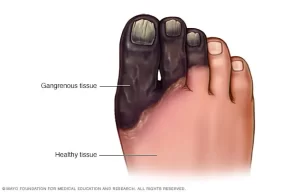
Foot gangrene is a serious condition that occurs when the tissues in the foot die due to a lack of blood flow. It is most commonly caused by underlying conditions such as diabetes, peripheral artery disease, and atherosclerosis. Foot gangrene is a medical emergency and requires immediate treatment.
Symptoms of foot gangrene may include:
- Pain or discomfort in the affected foot
- Discolouration of the skin, ranging from red or purple to black
- Numbness or tingling in the affected foot
- Sores or ulcers on the skin that do not heal
- Foul odour from the affected foot
- Shiny or tight-looking skin over the affected area
If you suspect you have foot gangrene, it is important to seek emergency medical attention. Treatment may include:
- Debridement: The affected tissue may need to be surgically removed to prevent the spread of infection.
- Antibiotics: If an infection is present, antibiotics may be prescribed to treat the infection.
- Hyperbaric oxygen therapy: In some cases, hyperbaric oxygen therapy may be used to improve blood flow and promote healing.
- Amputation: In severe cases, amputation of the affected foot or toe may be necessary.
Preventing foot gangrene involves managing underlying conditions such as diabetes and peripheral artery disease, and practicing good foot hygiene. It is important to seek prompt medical attention for foot gangrene to prevent further complications and ensure proper treatment.
